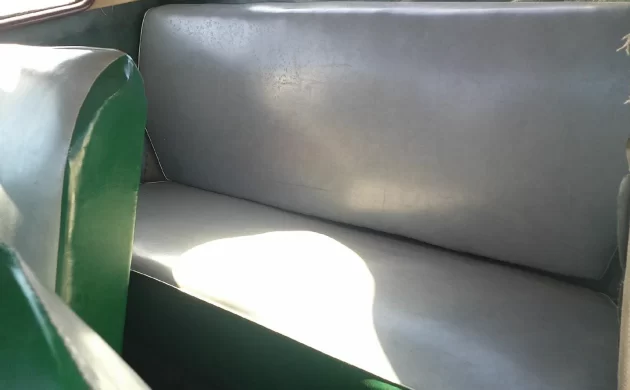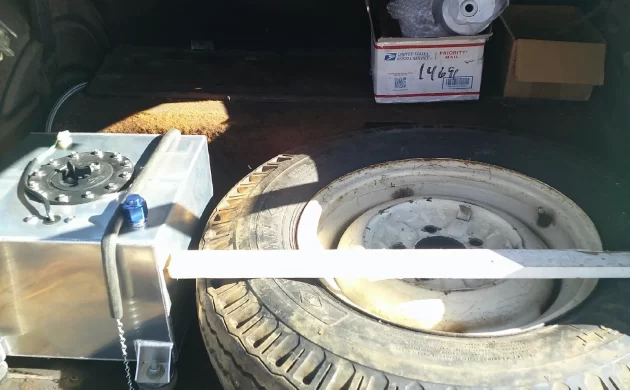Prewar Pontiac with Patina: 1939 Pontiac Business Coupe

As the market for the average prewar car declines, bargains continue to emerge every day. Not long ago finding a running prewar coupe, or any running prewar car for that matter, for under $10,000 was almost impossible. Now there are some really interesting choices out there for collectors at prices that won’t break the bank. This 1939 Pontiac business coupe for sale on eBay in Valley View, Texas is a good example. A running and driving coupe, with a claimed 18,499 miles, is currently sitting at $4,450 with less than three days to go. Can you see yourself behind the wheel of this preserved prewar coupe?

The details on this Pontiac are interesting. It is advertised as a 1939 Pontiac business coupe with an inline six-cylinder engine and a three-speed manual transmission. 1939 was the first year that Pontiac put the shifter on the steering column, better known as “three on the tree.” Most makers transitioned from floor shifters to column shifts in that time frame. Regardless, the car is advertised as still having its factory white exterior paint and original interior, and they state that it has 18,499 miles on the odometer.

Pontiac had two separate body lines and two different engines available in 1939 due to low sales in 1938. The lower cost line was branded the Quality Six. These cars had Pontiac front ends but wore Chevrolet bodies. The DeLuxe Six and DeLuxe Eight were larger, and almost all Pontiac. Only their bodies were shared with stablemates Oldsmobile, LaSalle, and Buick. This move did accomplish its goal, with the nameplate selling more than 140,000 cars in 1939.

Judging by the number of options on this car and the body’s similarities to that of a 1939 Buick coupe, it is a fair assumption that this is a DeLuxe Six. Among the options seen are bumper and grille guards, a horn ring, a radio, a clock, and a heater. The seller’s belief that the interior is original is mostly disproven by the vinyl that covers the seats. The headliner and door panels may still be original though.

A peek in the backseat shows a surprising amount of room for a coupe of this era. Most of these coupes offered only opera seats where the passengers faced each other, or no seats at all. Legroom, or lack of it, proves that you can only do so much with a prewar coupe body.

The trunk opens to reveal a rather unoriginal sight. Bolted down next to the spare tire is a fuel cell. This fuel cell does not look to be very large in capacity and was likely a workaround for a gunked-up fuel tank. There are a few companies out there making reproduction gas tanks nowadays within the rough ballpark of fitting perfectly. If this is a body shared with more distinguished stablemates, chances are good someone is making a tank that will kind of fit.

Under the hood lies Pontiac’s 222 cubic inch inline-six-cylinder engine. The pictures reveal an engine still wearing almost all its original equipment. The water pump, voltage regulator, and coil all seem to be replacements. I am curious about what looks to be an oil tube with a cap on it just ahead of the distributor. Does a canister-style breather usually fit there? If anyone has an idea, please let us know in the comments.
One interesting fact uncovered in researching this car is that Pontiac’s six-cylinder engines (and maybe eight-cylinder engines) were equipped with cast iron pistons. Most engines by that time had switched to aluminum pistons. The drawback with aluminum was that the metal had a different expansion and contraction rate than the cast iron blocks of the era. By using iron pistons, Pontiac could make engine tolerances tighter. The trade-off was that pushing the engine to high RPMs regularly would greatly stress the connecting rods due to the greater reciprocating mass. You could usually get by with a longer period before a rebuild due to piston rings, but leadfoots found other weak points quickly and expensively.
As always, before you plunk down the case to buy this car, an inspection would be prudent. While there are less than three days left in the auction, that inspection may be difficult to pull off in time. The ad suggests that the seller is looking for $11,500 or the best offer. With bidding sitting at $4,450 and not yet off reserve, this one will most likely be up for sale again. Just in case, write down the contact information and call after the auction is over. Somewhere between the sale price and the $11,500 is the sweet spot here. This looks to be a solid car that would be enjoyable to own.
Auctions Ending Soon
 1969 Ford MustangBid Now1 days$800
1969 Ford MustangBid Now1 days$800
 1965 Ford Falcon Station WagonBid Now4 days$2,300
1965 Ford Falcon Station WagonBid Now4 days$2,300
 2002 Jaguar XK8 ConvertibleBid Now5 days$3,500
2002 Jaguar XK8 ConvertibleBid Now5 days$3,500
 1979 Chevrolet Camaro Z/28Bid Now6 days$1,500
1979 Chevrolet Camaro Z/28Bid Now6 days$1,500
 1960 Dodge D300Bid Now6 days$100
1960 Dodge D300Bid Now6 days$100

Comments
It never ceases to amaze me how cars like this stayed intact for so many decades,avoiding the customizer’s torch or the metal muncher’s jaws. A really nice copy here.
Jeff, I don’t think this is a business coupe but rather a club coupe; aka a two door sedan even if the seller calls it one. Business coupes typically have no rear seat and an oversized trunk. Also there is another style of coupe from this era usually referred to as an opera coupe. Its defining characteristic is two small jump seats in the space behind the front seat. Not trying to be critical here but as a business coupe aficionado I had to throw in my 1&1/2 cents worth.
I believe you’re right Bob.
My family inherited a 1940 Oldsmobile business coupe, and it only had a small shelf ni the back with a looooong trunk.
I reckon the year to have been around 1953-1955 when my oldest brother (RIP Bill) bought a 39 Pontiac 4 door. It was a sort of reddish-orange color. He didn’t have it long before it joined the collection of old worn out cars that adorned a hill in the back of my dad’s farm. After dad retired, sold the farm and moved to Honolulu in 1974 the cars were all taken to the scrap yard. Some of those old beaters were quite rare, like the 39 Dodge 7 passenger jump seat sedan. There were many old Buicks and Dodges on that hill. A couple of Desoto’s a Chevy or two and Mercury. It’s been a long time now but I sure have some fond memories of that old country farm in Shasta County, California. I got away with more than most kids because my dad was chairman of the school board. What memories just the site of an old Pontiac can bring about.
God Bless America
I’m not sure, but think this is a Deluxe Coupe. 1939 Pontiacs came on either a 115″ wheelbase for the coupes or 120″ for the sedans. I don’t think this would be a 2-door sedan, because of the small rear windows and pronounced trunk.
Bid is now $6000 and seems low for a nominally original low-mileage vehicle. His reserve is probably $9000.
But these make a nice pre-war Sunday driver already with hydraulic brakes. Unlikely to have opera seats, but they’re a nice addition for the grandchildren. I’d agree with Jeff that a return to an original fuel tank would be necessary.
The flathead engines don’t permit freeway speeds, but are easy to maintain. Replacing the baffit bearings may be difficult but maybe she’ll bearings are possible????
Certainly worth preserving as-is rather than resto-rodding.
A 1939 Chev. would probably have the same gas tank.
The hose is for a pcv valve, California car.
These years are a little early for PCV valves? Most cars had a blow by tube pointing to the bottom to vent.
California vehicles got PCV valves for 1961. They went nationwide in 1963.
Body tag says 2627B, so it’s a DeLuxe Business Coupe with a 6cyl.
DeLuxe Business Coupe, 3 Pass., 120″W.B. ………………..26 ……2627B …6
DeLuxe Business Coupe, 3 Pass., 120″W.B. ………………..28 ……2827B …8
DeLuxe Convertible Coupe, 5 Pass., 120″W.B. ……………..26 ……2667 ….6
DeLuxe Convertible Coupe, 5 Pass., 120″W.B. ……………..28 ……2867 ….8
DeLuxe Sport Coupe, 5 Pass., 120″W.B. …………………….26 ……2627 ….6
DeLuxe Sport Coupe, 5 Pass., 120″W.B. …………………….28 ……2827 ….8
I stand corrected then. Pontiac certainly could have identified the body style however they wanted. But I still stand by my assertion that the designation “business coupe” traditionally means only a front seat with the trunk taking up the space where a rear seat would be. This body style significantly alters the profile of the vehicle: an elongated rear end. This has been polarizing for some people who have written into BF that they find this ugly. Quite to the contrary; I love it. My 1952 Plymouth is listed as a club coupe in the manufacturer literature I have. My car has a two doors and a back seat. To my thinking my car is a two door sedan. But as they say, a rose by any other name. GLWTS.
Carbob: Ford sold more Business Coupes than anyone & their Business Coupes had rear jump-seats, I think they called them Opera seats. In Wikipedia’s definition of a Business Coupe, it mentions removeable rear seats.
Carbob: Here is a picture of what a 2-door sedan from the late 30’s and 40’s typically looks like. This example is, in fact, a 39 Pontiac 2 door sedan. I don’t mind educating young whippersnappers!
Breather , oil fill cap combo. No pcv until 1964. Should have road draft tube on right rear of engine.
I have a 1938 Pontiac Business coupe that originally had the fold down rear seats. 1938 was actually the first year for 3 on the tree which mine had. This was our first family car that brought me home from the hospital when I was born in 1943. Dad bought used in 1941. It had a 6 banger engine with cast iron pistons. Dad used it in business travels and it had about 137,000 miles on it and was about worn out. Today that mileage is just well broke in.
I had put a 1950 Olds V8 $40.00 engine in it that went south shortly after I installed it. I had to move the battery to the trunk to accommodate the wide Olds V8
I still have it today after it was sold when I went to college. I got it back street rodded with a 350 Chevy mill and a full back seat in 1988.
I knew for sure it was my old car when I saw the rotted out welding cables I used to put the battery in the trunk when I was re-wiring it in 1995.
This was my family’s car for over 35 years. Dad sold it after he got Alzheimer’s, not knowing what he was doing.
It is far from “original” –
* The radiator is from an 8-cylinder model
* The canister is an aftermarket “positive crankcase ventilation system” dad put on it
* The back seat came out of a Mercury’s
* My mother did the upholstery
* The engine came from Montgomery Ward – I believe it was a rebuilt one they used to sell
* Dad did the paint job in 1951. The original color was tan.
* Mom installed the headliner
* The rear fender guards came from JC Whitney
* I installed the woodgrain vinyl on the dash in the 70s as a teenager
Sure wish I could get it back.